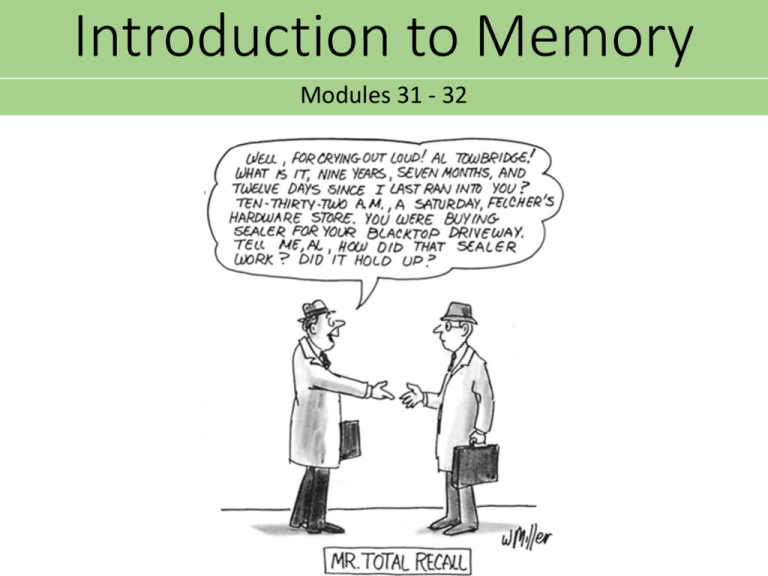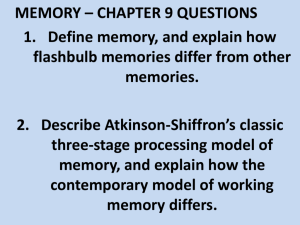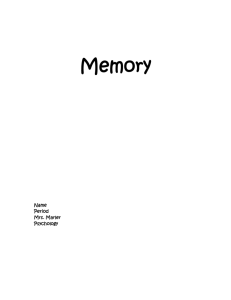memory - Mr. Hunsaker's Classes
advertisement

Introduction to Memory Modules 31 - 32 Opening Activity • Get out a blank piece of paper • Write down all the responses that come to mind, in the order they come to mind • Name the seven dwarfs. What is Memory? • To psychologists, memory is learning that has persisted over time; it is information that has been acquired, stored, and can be retrieved. • Research on the extremes helps us understand more about memory • Examples of extremes • Clive Wearing – lost memory • Joshua Foer – winner 2006 USA Memory Olympics Memory Models • Information-processing models are analogies that compare human memory to a computer’s operations. • Encoding describes getting information into our brain. • Storage describes how we retain information. • Retrieval describes how we later get the information back out. Memory Models • Like all analogies, computer models have their limitations. • Computers process sequentially where human dual-track minds process simultaneously. • Parallel Processing describes the processing of many things simultaneously. • Enter the classroom; see the warm-up, hear conversations, think about last class, etc. Memory Models • Connectionism model promotes the idea that neural connections are changed or strengthened when you learn something. • Atkinson and Shiffrin propose a threestage model: 1. We first record information as a fleeting sensory memory. 2. From there, we process information into short - term memory, where we encode it through rehearsal. 3. Finally, information moves into long term memory for later retrieval. Memory Models • Atkinson and Shiffrin three-stage model External Events Sensory Memory Long-term Memory Memory Models Others have modified the Atkinson and Shiffrin model to include the idea of working memory. • Working memory is a newer concept of shortterm memory that focuses on conscious, active processing of incoming auditory and visual-spatial information and of information retrieved from long-term memory. Memory Models Alan Baddeley’s working memory model Memory Models Modified three-stage model that includes the idea of working memory. Automatic Processing Maintenance Rehearsal External Events Sensory Sensory Input Sensory Memory Encoding Working Short-term Memory Attention to important or novel information Encoding Retrieving Long-term Memory Storage Building Memory: Encoding Effortful –vs– Automatic Processing • Atkinson & Shiffrin’s model focused on explicit memories. • memory of facts and experiences that one can consciously know and “declare.” (Also called declarative memory) • We encode explicit memories through conscious, effortful processing. • encoding that requires attention and conscious effort. Building Memory: Encoding Effortful –vs– Automatic Processing • Example of effortful processing: .citamotua emoceb nac gnissecorp luftroffE • At first this requires effort, but with practice it can become more automatic. Building Memory: Encoding Effortful –vs– Automatic Processing • Automatic processing skips the conscious track and happens without awareness. • unconscious encoding of incidental information such as space, time, frequency, and of well-learned information such as word meanings. Building Memory: Encoding Effortful –vs– Automatic Processing • Examples of automatic processing: • Space: you encode the place on a page where certain information is located. • Time: you unintentionally note the sequence of events that happened in your day. • Frequency: you effortlessly keep track of how many times things happen to you. Homework • Reproduce the modified three-stage processing model of memory on the bottom of page 319 in your textbook. • Be prepared to recall information from this model.









